Energy & Power Systems > Completed Projects
Completed Projects
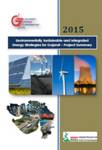 Environmentally Sustainable and Integrated Energy Strategies for Gujarat Environmentally Sustainable and Integrated Energy Strategies for Gujarat
IRADe prepared a strategy document on “Environmentally Sustainable and Integrated Energy Strategies for Gujarat”, supported by Gujarat Power Corporation Limited (GPCL). Under the project, the socio-economic aspects, energy and environment profile of the state are studied to calculate the energy demand for the next two decades.
Based on current energy scene, energy requirements were worked out for a number of scenarios of economic growth and structure of the economy and technology. While exploring supply strategies the following factors are taken into account, energy imports, conservation, energy access to consumers at affordable cost, infrastructure needed, energy pricing and emissions. Energy-mix needed for meeting out the energy demand is detailed along with energy supply strategies for 2035.
Under the project IRADe had 3 high level stakeholder consultation meetings at Gandhi Nagar to take the views of all the concerned energy and power sector professionals from Central and State Government and Private Sector Operators.
Supported by
Gujarat Energy & Petrochemicals Department & Gujarat Power Corporation Limited (GPCL)
Download Report
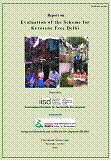 Analysis of Kerosene-free Delhi Scheme Analysis of Kerosene-free Delhi Scheme
Kerosene-free Delhi’ (KFD) scheme was launched by the Delhi Government in 2012. It gave a free LPG cylinder, a two- burner gas stove, regulator and gas pipe to ration card holders using kerosene. IRADe found the scheme to be reasonably successful as it reduced indoor air pollution but, at the same time, it failed to include the poor as it focused only on the holders of ration cards, thus excluding the others, i.e. the homeless with no identity card or address. It was also found that some kerosene use continued to bridge days between the order and delivery of a gas cylinder. IRADe recommended supply of 5 kg cylinders. The government has recently announced that supply of 5 kg cylinders will be increased.
Sponsored by
International Institute for Sustainable Development (IISD)
Download Report
Assessing the Impacts of Diesel Subsidy Reform since January 2013
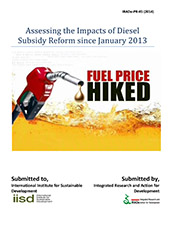 Diesel accounted for 39.55% out of total petroleum products consumption in India in 2012-13 (Energy Statistics 2014). This makes diesel an important petroleum product whose consumption and pricing has major macro economic implications. The study “Assessing the Impacts of Diesel subsidy reform since January 2013” by IRADe critically evaluates how the diesel price reforms impacted the important stake holders in the economy. The annual diesel consumption shows a negative growth rate for the first time in last five decades in 2013-14. As per IRADe findings, decontrol of diesel prices resulted in overall increase in WPI (Wholesale Price Index) inflation but it has turned out to be temporary in nature. The elasticity of overall wholesale price inflation with respect to diesel price change is quite lower. The wholesale price of food is largely influenced by rainfall, seasonal impacts and market forces and diesel price change has a very small impact on it. IRADe’s Analysis shows that the persistent CPI inflation is because of hike in food prices and not because of diesel prices. In the report we conclude that when CPI inflation is controlled, the RBI is likely to respond by reducing the real interest rate which will stimulate economic growth and reap the benefits of diesel reforms. Diesel accounted for 39.55% out of total petroleum products consumption in India in 2012-13 (Energy Statistics 2014). This makes diesel an important petroleum product whose consumption and pricing has major macro economic implications. The study “Assessing the Impacts of Diesel subsidy reform since January 2013” by IRADe critically evaluates how the diesel price reforms impacted the important stake holders in the economy. The annual diesel consumption shows a negative growth rate for the first time in last five decades in 2013-14. As per IRADe findings, decontrol of diesel prices resulted in overall increase in WPI (Wholesale Price Index) inflation but it has turned out to be temporary in nature. The elasticity of overall wholesale price inflation with respect to diesel price change is quite lower. The wholesale price of food is largely influenced by rainfall, seasonal impacts and market forces and diesel price change has a very small impact on it. IRADe’s Analysis shows that the persistent CPI inflation is because of hike in food prices and not because of diesel prices. In the report we conclude that when CPI inflation is controlled, the RBI is likely to respond by reducing the real interest rate which will stimulate economic growth and reap the benefits of diesel reforms.
This Project is supported by International Institute for Sustainable Development (IISD).
Download Report
The Impacts of India's Diesel Price Reforms on the Trucking Industry
"The Impacts of India's Diesel Price Reforms on the Trucking Industry" evaluates the impact of higher diesel prices on India's road freight transport sector.
The report finds that the trucking industry is
vulnerable to higher fuel costs, and supports the earlier evidence that the
fuel costs account for around 55 per cent of their total operating costs. However, the main finding of the study is that
the industry’s weakness is primarily grounded in structural constraints that
have squeezed profit margins, while providing truckers with little leverage to
pass on higher costs to clients. The study suggests that addressing these
constraints—more so than subsidizing the cost of fuel—is the solution to the
long-term profitability of the industry.
The industry suffers from oversupply due to the
lack of training stipulations, relaxed registration requirements and easy
financing. Eighty per cent of truck operators are small truckers who own less
than five trucks. Such small operators cannot reap the benefits of economies of
scale and cannot afford to obtain the necessary business information and are
thereby dependent on brokers. Due to oversupply of trucks and fierce
competition, freight rates are mostly determined by demand for trucking and
thus, increased fuel costs have little influence on them. But fuel costs being
around 55 per cent of the total operating costs, truck operators are vulnerable
to increased diesel price.
A substantial amount of evidence suggests that a
reduction in diesel under-recoveries will have significant fiscal and economic
benefits to India’s economy as a whole. However, higher prices will negatively affect industry and diesel-intensive
sectors—of which the trucking industry is one of the most obvious.
Supported by the International Institute for Sustainable Development (IISD)
Download Report
Download Research Report.
Taming Diesel Subsidy to Curtail Inflation and Foster Economic Growth 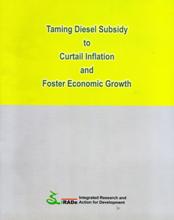
Government
is reluctant to raise diesel price fully for fear that it might lead to
inflation, even though administered price of petroleum products leads to large
under-recoveries. Partial financing of under-recoveries by the government is
done by direct budgetary support and indirectly by the Public sector oil
marketing companies (OMCs) and upstream oil companies (ONGC and OIL). These high
levels of under-recoveries raise the fiscal deficit, which in turn leads to
higher money supply resulting in higher inflation prompting Reserve Bank to
raise interest rate that lowers investment and economic growth rate over time.
While steps have been taken by the government to decontrol prices of petrol,
LPG and kerosene, diesel continues to be heavily subsidized, as a change in
status quo may lead to inflation in the short term. To explore this trade-off
between short term impact and medium term outcomes, IRADe has conducted a study
titled ‘Taming Diesel Subsidy to Curtail Inflation and Foster Economic Growth’.
The aim of the study is to assess the alternative road maps for diesel price
reform in India.
Key findings are:
- Continuing with present policy of subsidizing
diesel price is not tenable. This could have very large economic costs in
the long term.
- Full increase, which is a one shot increase of
30%, in the diesel price leads to some immediate increase in inflation;
however, continuing with present subsidy involves a much higher rate of
inflation later and which persists over a longer time. The average
inflation rate over 3 years will be 6.6 percent if diesel price is
decontrolled but would be 9% if diesel subsidy continues. Such high
overall inflation hurts the poor even more than the increase in diesel
price.
- The trade-off between short term negative
impacts and long term benefits is not just with inflation, but also for
GDP. The growth rate would be 8% with price decontrol and only 6.5%, if we continue with the present policy.
The loss in GDP will hurt poor whether they use diesel or not.
Sponsored by Shakti Sustainable Energy
Foundation and the Ministry of Finance.
Download Report
Overview and Assessment of Indian
Renewable Energy and Rural Electrification
Programme in the Context of Rural
Development:
This inception study on Renewable
Energy Component of the Indo-German Energy Programme
gives an overview and assessment of the National and
State policies to promote renewable energies, rural
electrification and relevant issues in rural development.
Along with it the relevant institutions and stakeholders
of the GOI programmes, were covered that are to guide
energy investment in this sector.
Sponsored by GTZ-German Technical
Corporation.
Indian Renewable Energy Status
Report - Background Report for DIREC 2010
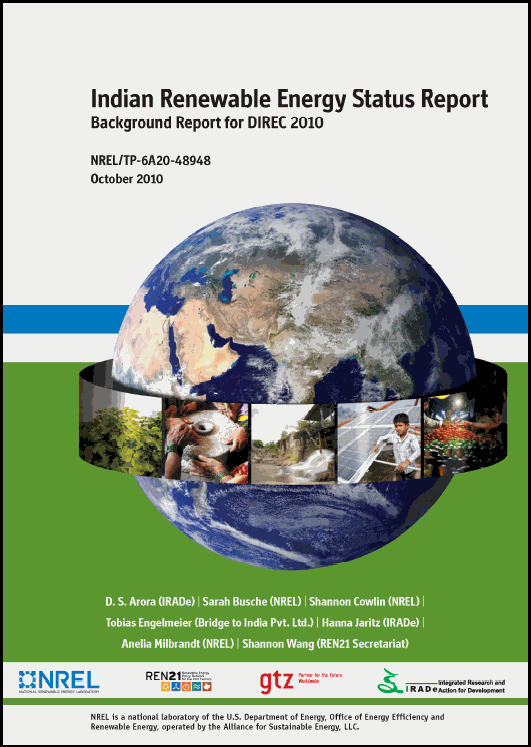 The
"Indian Renewable Energy Status Report"
was considered as a background report for the DIREC
(Delhi International Renewable Energy Conference)
2010 on behalf of the "Renewable Energy Policy
Network for the 21st Century - REN21". Basis
of this report was a study from the German Technical
Cooperation (GTZ) for the German Federal Ministry
for Environment, Natural Conservation and Nuclear
Safety (BMU). In addition to GTZ the report was produced
with the collaboration of experts from the U.S. Department
of Energy's National Renewable Energy Laboratory (NREL),
REN21 and BRIDGE TO INDIA Pvt. Ltd. The
"Indian Renewable Energy Status Report"
was considered as a background report for the DIREC
(Delhi International Renewable Energy Conference)
2010 on behalf of the "Renewable Energy Policy
Network for the 21st Century - REN21". Basis
of this report was a study from the German Technical
Cooperation (GTZ) for the German Federal Ministry
for Environment, Natural Conservation and Nuclear
Safety (BMU). In addition to GTZ the report was produced
with the collaboration of experts from the U.S. Department
of Energy's National Renewable Energy Laboratory (NREL),
REN21 and BRIDGE TO INDIA Pvt. Ltd.
Sponsored by: Deutsche Gesellschaft
fuer Internationale Zusamenarbeit (GIZ, formerly GTZ
-
German Technical Cooperation) www.giz.de
The report gives a comprehensive
review of the Indian Energy and Renewable Energy Status
in general, followed by an extensive look into the
renewable energy sources like wind, solar, small hydro
and biomass. These chapters include topics on estimated
resource potential, existing installation rate, policies,
investment flows and industrial trends in India. Furthermore
the report covers the potentials of renewable energy
for India to provide access to remote, unelectrified
populations and ended with the discussion of technology
transfer and the status of financing of renewable
energy technologies in India.
Download
Report
Analysis
of Carbon Capture and Storage (CCS) technology in
the Power Sector in India 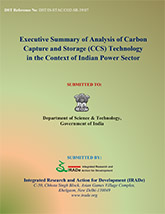
In the study of CCS technology in
relation to India's Power Sector, IRADe projected
emissions of CO2 from power plants in future, carried
out literature survey to identify developments in
carbon capture technology and evaluated each technology
for its economical and technical viability. Specification
of sequestration sites, identification of the way
forward for development, evaluation of monitoring
options of CCS, regulatory issues were discussed .
The study provides an opportunity for policy makers
to engage in debates. The study recommended that the
impact of CCS on the cost of power generation should
be assessed with various options to define appropriate
technology and costs under Indian conditions.
Sponsored by The Department of Science and Technology,
(GoI).
Download
Report
Identifying Specific Policy Options with the Aim of Reducing Carbon Intensity in India
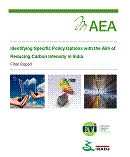 Government of India has announced the National Action Plan on Climate Change (NAPCC) and its constituent eight missions prepared under the aegis of the Prime Minister’s Council and furthermore, an ‘Expert Group on Low Carbon Strategies for Inclusive Growth’ chaired by Dr. Kirit Parikh, has been set up to provide technical and policy options to reduce 20-25% emission intensity by 2020. Various other countries are aggressively pursuing low carbon growth plans, and by rapidly disseminating the lessons globally learned in implementing low carbon growth plans and particularly from UK/EU experience and applying them to the challenges faced in India, India may be able to leapfrog these experiences and accelerate the implementation of policies that are a deviation from the business as a usual scenario. Under this context, the aim of this study project was to provide practical recommendations on low carbon policy options to support the ‘Expert Group on Low Carbon Strategies for Inclusive Growth’ appointed by the Planning Commission to reduce India’s emission intensity. The study aims to provide practical recommendations for the policy landscape in India, specifically in three key domains identified by stakeholders: Renewable Energy Certificates (RECs), Green/Energy Efficient Buildings and Low Carbon Institutional Framework. The study 'Identifying specific policy options with the aim of reducing carbon intensity in India' is undertaken by AEA, Emergent Ventures India and IRADe, and is supported by the British High Commission. Government of India has announced the National Action Plan on Climate Change (NAPCC) and its constituent eight missions prepared under the aegis of the Prime Minister’s Council and furthermore, an ‘Expert Group on Low Carbon Strategies for Inclusive Growth’ chaired by Dr. Kirit Parikh, has been set up to provide technical and policy options to reduce 20-25% emission intensity by 2020. Various other countries are aggressively pursuing low carbon growth plans, and by rapidly disseminating the lessons globally learned in implementing low carbon growth plans and particularly from UK/EU experience and applying them to the challenges faced in India, India may be able to leapfrog these experiences and accelerate the implementation of policies that are a deviation from the business as a usual scenario. Under this context, the aim of this study project was to provide practical recommendations on low carbon policy options to support the ‘Expert Group on Low Carbon Strategies for Inclusive Growth’ appointed by the Planning Commission to reduce India’s emission intensity. The study aims to provide practical recommendations for the policy landscape in India, specifically in three key domains identified by stakeholders: Renewable Energy Certificates (RECs), Green/Energy Efficient Buildings and Low Carbon Institutional Framework. The study 'Identifying specific policy options with the aim of reducing carbon intensity in India' is undertaken by AEA, Emergent Ventures India and IRADe, and is supported by the British High Commission.
Key Recommendations
Renewable Energy Certificates (RECs):
-
Ensuring policy certainty and regulatory compliance by demonstrating a national policy commitment for RECs by setting appropriate targets that aligns with the national level targets of renewable energy generation.
-
Setting uniform RPO targets across states in India , set Minimum Price guarantee for RECs and strengthening the penalty mechanism
Green and energy efficient building standards:
- Promote the uptake of green and energy efficient building standards by incentivising owners and developers to overcome barriers related to capital intensity, high cost and general reluctance to move from existing practice. Central financial assistance could be provided to city municipalities and other local bodies to finance these incentives.
- Reduce the knowledge gaps and promote greater sharing of information amongst technical experts and developers to incorporate Green building/ energy efficiency techniques in building design and construction.
- Stricter regulatory provisions and mandating standards for making designers and contractors for rapid adoption of techniques and technologies for green and energy efficient buildings.
Low carbon governance and institutional framework:
- A special unit such as the Low Carbon Growth Unit (LCGU) could be set up in planning commission to focus expressly on delivery of those aspects of the 5-Year Plan with climate elements linked to the NAPCC.
- A new dedicated committee was established by the Prime Minister, under the PM Council, to track the progress of the NAPCC Missions with clear recommendations of what improvements can be made.
- Improving the institutional framework to support private sector action
Download Report
Indian Perspectives on Global Energy Scenarios till 2050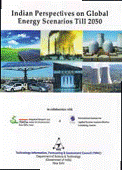
TIFAC supported a collaborative project with International Institute for Applied Systems Analysis (IIASA), Austria. The objective was to understand energy transition needed in India that is consistent with global perceptions and to identify research and development required for the transition. IRADe studied IIASA’s energy scenarios for global regions from India’s perspectives. The project provided a global energy vision for India till 2050.
In IIASA’s scenario, carbon capture and storage (CCS) played an important role. IRADe scenario without CCS pushed more nuclear and gas plants along with renewables. IRADe’s work with IIASA helped identify technologies for the energy transition needed for sustainable development including for combating climate change. It also helped India to present its perspective in the development of global energy scenarios that reflects India’s concerns.
Sponsored by
Technology Information, Forecasting and Assessment Council (TIFAC)
Evaluation of impact of RGGVY and issues in implementation of RGGVY
Under the project, IRADe was to study in five states – Assam, Gujarat, Himachal Pradesh, Rajasthan and Uttar Pradesh – the progress of village electrification in terms of coverage and quality of coverage (such as infrastructure, electrification of Below Poverty Line (BPL) households, etc.). One of the main objectives is to list various Governments and their agencies responsible for various tasks for successful implementation of RGGVY projects and comment on the efficiency in fulfilling those responsibilities. IRADe studied 25 districts and 125 villages i.e. five districts in each state and five villages in each district. Implementation issues for RGGVY were discussed with various government agencies, Discoms, district officials, village panchayats and households. We found that good quality rural electricity distribution infrastructure was built and positive socio-economic impact was observed. Also, while BPL consumers benefited, there was a need for wider acceptance by Above Poverty Line (APL) households to receive and pay for electricity for better utilization of the distribution network and its economic viability. The next phase of the programme should address these issues. scheme, ‘electrified’
Sponsored by
Rural Electrification of India (REC), Government of India
Monitoring and Evaluation of Off-Grid Solar Photovoltaic Systems Installed in Punjab and Himachal Pradesh in the Years 2008, 2009 and 2010
Ministry of New and Renewable Energy (MNRE) is implementing a country-wide Solar Photovoltaic programme (SPV) of demonstration and promotion of solar photovoltaic lighting systems, stand-alone power plants and other new and specialized systems in the country. The evaluation was conducted through surveys of beneficiaries and discussions with the officials of MNRE and state nodal agencies (PEDA of Punjab and Himurja of Himachal Pradesh). It was found that a large percentage of systems installed were working.
Supported by
Ministry of New and Renewable Energy, Government of India
Evaluation of Franchise System in Assam, West Bengal, Nagaland and Rajasthan
The Ministry of Power (MoP) had awarded a study to IRADe to assess franchise systems in Assam, Nagaland and West Bengal. Rural Electricity Corporation (REC) awarded further studies to IRADe for evaluating the franchise systems operating in different district distribution circles in Assam, West Bengal, Nagaland and Rajasthan through sample villages in these states. This project covered villages in Bankura and Dibrugarh districts in West Bengal & Assam and the REC project survey included villages in Purulia, Jodhpur and New Bongaingaon districts. Conclusions were drawn from the studies that franchises require adequate supply of good-quality power maintained by utilities to work effectively. Also capacity building of franchises should be done at the beginning.
Supported by
Ministry of Power, Government of India
Evaluation of Solar Thermal Demonstration Projects in Four States of India
The MNRE had provided solar cookers and solar water heaters to the residents of villages in four states namely Rajasthan, Haryana, Uttarakhand and Gujarat. Overall, the users of solar thermal products were satisfied. 90 per cent of the users felt that food cooked with solar cookers tasted better and was healthier. They were happy that the solar cooker does not require fuel and needed little maintenance. They were aware that these products had a long operational life, but could only be used during the day, and their effectiveness depended on the season.
Supported by
Ministry of New and Renewable Energy, Government of India
Evaluation of Solar Photovoltaic Programme in Six States of India
The MNRE had provided village residents in six states, namely Rajasthan, Haryana, Uttarakhand, Gujarat, Manipur and Karnataka, with solar technologies such as home lighting systems, water pumps, lanterns and street light systems. Evaluation done by IRADe for MNRE through the field visits focused on verification and collection of beneficiary level information regarding functioning and maintenance of the solar systems and satisfaction level of beneficiaries. Their lifestyles have changed gradually following work done under the scheme. The benefits accrued were increased working hours for useful tasks, increased study hours of children, decline in consumption of kerosene and decline in environmental accidents such as snake and insect bites. Beneficiaries have started using mobile phones, radios, telephones etc.
Supported by
Ministry of New and Renewable Energy, Government of India
Survey and Evaluation of Remote Village Area Electrification Project through Solar Photovoltaic System in Rajasthan and Haryana
The MNRE had provided subsidy for solar homelighting and street-light systems to residents in the remote villages of India, which could not be covered by the national power grid. In the survey done by IRADe for MNRE, it was observed that a target-oriented approach was followed during its implementation. The implementing agencies did not fully adhere to the guidelines stipulated by MNRE. Approximately 15 per cent of the systems were found to be non-functional. Improvements in maintenance and service support from equipment suppliers are needed.
Supported by
Ministry of New and Renewable Energy, Government of India
Village Energy Security Programme in Vavdi and Vaddithar Hamlets in Patan District of Gujarat
Village Energy Security programme in Vavdi and Vaddithar in Patan District of Gujarat is a part of the Village Energy Security Programme under Remote Village Electrification programme of the MNRE. IRADe installed biogas plants, improved stoves,
wood gasifier based electricity generator and jatropha plantation for biodiesel in two villages, Vavdi and Vaddithar of Santalpur Taluka of Patan district of Gujarat. IRADe in close cooperation with the Self-Employed Women’s Association (SEWA), Gujarat Energy Development Agency (GEDA), the village Panchayat and village population implemented the programme that aimed to provide access to electricity through biomass resources to households in remote villages which are not likely to be covered through grid extension.
Biodigesters were set up in both the villages to provide lighting to 50 homes. Secretary, MNRE Mr. V. Subramaniam dedicated it to Vavdi village. 100 improved cook stoves were also distributed in each village at subsidized rates. Self-help groups were formed and were given electric flour mills, soap making units, etc., for income generation.
Supported by
Ministry of New and Renewable Energy, Government of India
Rural Microenterprise Model for Biofuel Extraction in India
IRADe formulated a microenterprise model for biomass-based energy system at the village level. The objective was to extract oil that provides an alternative source of fuel in rural areas. IRADe set up a biodiesel extrusion unit in Bawal, Rewari district of Haryana. The villagers were explained how to use the extraction machine and get biodiesel.
Supported by
Sustainable Energy Project Support (SEPS) of WISIONS,Germany
Natural Gas Demand by Indian Fertilizer Sector
Natural gas is the preferred feedstock for urea manufacture. The demand for natural gas for the next two decades was projected for the fertilizer sector. These projections were made in the context of changing government policies regarding the fertilizer industry, such as farm gate price regulation and self-sufficiency level of indigenous urea production. The current growth plan of natural gas supply and evolving supply scenario in the future were also considered in the study. Depending on the price of urea the need for natural gas was projected to be between 27 BCM and 34 BCM for 2025–26.
Supported by
Programme on Energy & Sustainable Development (PESD) of Stanford University, USA
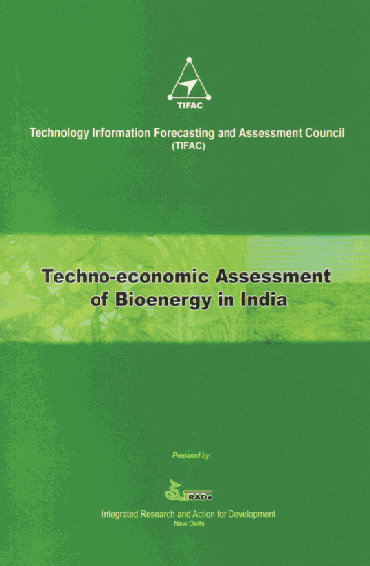 Techno-Economic
Assessment for Bio-energy in India : "
The study reflects on various issues
of bio-energy in India and identifies prioritized
investment opportunities for technology development
and its market adaptation under appropriate policies.
The study found that among various bio energy options
in India, biodiesel, bio ethanol and biomass gasification
are found to be most relevant areas, where investments
for technology and marketing development could be
made. Wastelands could be used for growing oil seed
plants for producing biodiesel, irrigated land for
sugarcane based ethanol production and small plots
in village location be used for producing fuel wood
for gasification. Thus their land requirements are
complementary, though they do compete with other uses. Techno-Economic
Assessment for Bio-energy in India : "
The study reflects on various issues
of bio-energy in India and identifies prioritized
investment opportunities for technology development
and its market adaptation under appropriate policies.
The study found that among various bio energy options
in India, biodiesel, bio ethanol and biomass gasification
are found to be most relevant areas, where investments
for technology and marketing development could be
made. Wastelands could be used for growing oil seed
plants for producing biodiesel, irrigated land for
sugarcane based ethanol production and small plots
in village location be used for producing fuel wood
for gasification. Thus their land requirements are
complementary, though they do compete with other uses.
Sponsored by Technology Information
Forecasting and Assessment Council (TIFAC)
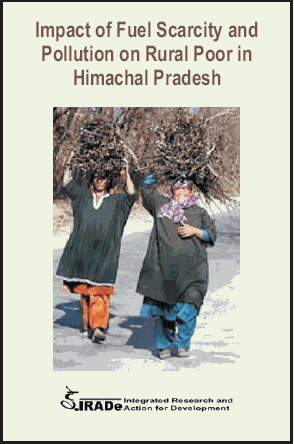
Impact of Fuel Scarcity and Pollution
on Rural Poor, 2004 Himachal Pradesh
The project was funded by Global
Development Network (GDN)
through its regional working group
(SANEI) South Asian Network, New Delhi. The research
project assessed the impact of scarcity of clean fuels
and traditional fuels. It assessed in economic terms
the impact of pollution from the use of traditional
bio-fuels on vulnerable groups of rural poor in Himachal
Pradesh in the context of their socio-economic circumstances,
access to fuel, needs and willingness to pay for cleaner
fuels. The key results included the household energy
consumption pattern, cooking behavior,
health profile, analysis of vulnerable
groups and toll on human resources, which showed that
about 21% of rural adults, might be having some respiratory
symptoms. Download
Report
Integrated Analysis of Diesel Substitutes
from Oil Seeds for India:
This study reviewed the entire mechanism,
beginning from an overview of the best biodiesel tree
plantation practices extraction and processing of
oil and finally the end uses of the product. A policy
framework for land availability for oil seeds plantation,
minimum support price for seeds, subsidies for farmers
for raising plantations, tax exemption for entrepreneurs
and sale of biodiesel is suggested. Institutional
mechanisms for raising nursery and plantation and
for carrying out R&D are also required. Financial
incentives could be provided to oil companies as they
will ensure quality oil and take various types of
risks. An action plan to reduce cost of production,
increase financial viability and market linkages was
also discussed for biodiesel production.
Sponsored by Petroleum Federation
of India (PetroFed), New Delhi
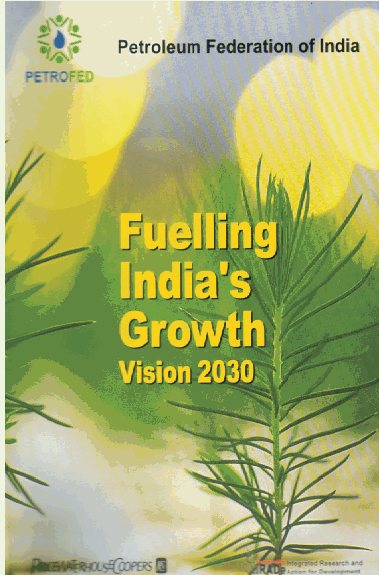
Fuelling India's growth vision 2030
This is a part of the continuing
initiative of the Petroleum Federation of India to
enhance awareness about the petroleum sector and current
issues concerning it and associated industry in India.
Integrated Research and Action for Development (IRADe)
assisted PwC in undertaking the econometric modelling
and projections for the study.
More
Information....
PROJECT RELATED WORKSHOPS
|